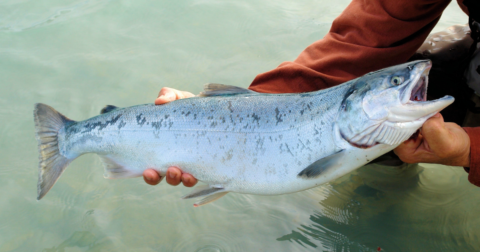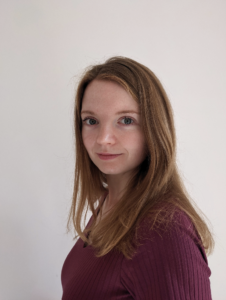Investigation
Oklahoma’s Loophole: How Tyson’s Water Use Goes Unchecked
Food•15 min read
Reported
The salmon industry plans to pack fish into land-locked tanks, at a massive energy and water cost.


Words by Molly Millar
Over the course of their lifetimes, wild Scottish salmon swim thousands of miles through the Atlantic ocean, passing Norway, Greenland and Newfoundland before returning to their native rivers to spawn. The image of a salmon swimming upstream might be the one many of us attach to the fish on our plates — but in reality, farmed salmon actually live cooped up by the thousands in large pens off Scotland’s west coast.
Now, a hugely ambitious new salmon farm in Grimsby, England has been given the green light to serve as a new alternative. Here, millions of salmon will spend their entire lives in tanks situated entirely on-land — 300 miles away from the epicenter of salmon farming in the UK. While the company behind the plans is framing it as an innovative solution, animal welfare advocates say this type of aquaculture could be even worse for fish.
The salmon aquaculture industry is one of the fastest growing segments of food producers in the world. In the UK, 205,000 metric tons of fish are produced every year, primarily in Scotland, but the industry hopes to double its output by 2030. The seafood industry is racing to satisfy consumers across the pond. In fact, one in five Scottish salmon are exported to the U.S., where demand for salmon rose by 10 percent between 2022 and 2023.
On a typical Scottish salmon farm, fish live in open-net pens along the coast, a type of aquaculture that kills off a huge share of fish prematurely, and fuels water pollution. Over 20 percent of farmed salmon in Scotland don’t make it to harvest — in fact over 17 million salmon died prematurely in 2023 according to industry figures, making it the worst year ever for fish mortality. Sea lice — parasites that eat the fish alive — are present in almost half of salmon farms and are one of the main reasons farmed salmon die in such high numbers. Another is the quick spread of disease in crowded pens.
Open-net salmon farms are also responsible for dumping pesticides and antibiotics into the water, which threatens other aquatic life. Around nine metric tons of antibiotics were used on salmon in 2021, as well as the neurotoxins used to treat sea lice.
There are other problems too. Sometimes salmon in pens escape, and “there is a risk that they go on to breed with wild populations of fish. That can have deleterious effects on the natural populations,” said Adam Hughes, PhD, a researcher on sustainable aquaculture at the Scottish Association for Marine Science. Since domesticated salmon are genetically distinct, interbreeding may endanger future generations of wild fish. Fish welfare campaigners blame salmon farming for decimating the populations of the fish’s wild counterpart, which is projected to decline by between 50 and 80 percent by 2025.
The proposed new salmon farm in Grimsby aims to solve that problem — by completely separating farmed salmon from the water and raising them from spawn to harvest in a warehouse-like structure on land. The UK’s first land-based salmon farming facility aims to solve these problems while breeding ever greater numbers of fish — at 5,000 metric tons a year, its anticipated output will double that of most Scottish salmon farms. The facility will harness Recirculating Aquaculture Systems (RAS) to mirror the natural flow of currents. Aquacultured Seafood Ltd, the company behind the Grimsby site, argue this approach will mitigate the concerns associated with open-net salmon farming: there’s no chance the salmon will escape, and waste is managed on-land, protecting wild fish and avoiding the direct flow of pollution associated with salmon farming. It also claims it will be able to completely eliminate disease and parasites from the farming process.
But while the environmental protections from farming on-land might sound good on paper, campaigners and researchers are more skeptical.
“The big reason the industry gets excited about RAS, or any closed containment, is they can basically farm more fish,” said Wasseem Emam, director and lead researcher at Ethical Seafood Research, a research and consulting organization dedicated to fish welfare. Crowded conditions are all but guaranteed. Since these land-based circulating systems are so expensive, high stocking density is necessary for producers to make a profit. While maximum stocking density for Scottish net pens is 2 percent fish to 98 percent water, the figure is more like 6-10 percent fish for on-land systems. Packing more fish into close quarters makes fish far more likely to be stressed out, which in turn increases their susceptibility to disease. In other words, fish welfare campaigners are doubtful that the company can make good on its boldest claims.
“Without a doubt, new diseases will emerge because of these sites,” said Abigail Penny, executive director of Animal Equality UK. “In onshore shrimp farms, for example, new diseases crop up routinely, and have been devastating.” Penny suspects these new types of salmon farms will have new consequences. “I suspect we’re going to be seeing new problems [of] different diseases,” she says. And while land-based farms might solve some problems, Penny argues, “it will bring more [problems] than it resolves.”
Land-based salmon farms are incredibly water-intensive — to produce one salmon fillet requires the same amount that a person drinks in a year. These facilities are also incredibly energy-intensive. In open-net farming, “the salmon are supported by the environment,” said Hughes. “The amount of energy that you need to produce a kilo of salmon is much lower than the amount of energy to produce a kilo of beef, pork, lamb or chicken.” That’s not the case when you need to power massive tanks in a way that mimics natural currents to refresh the water — the energy usage of the Grimsby site could power 3,200 homes a year, said Animal Equality UK. One study found that farming salmon in a land-based system generated more than double the emissions of ocean pen production.
The energy-dependence creates new risks to the fish too. “With that additional control comes a much higher likelihood of failure, whether that’s mechanical failure or human error,” said Penny. “The accidental flick of a switch or pressing the wrong button could mean that hundreds of thousands of fish die overnight.”
Aquacultured Seafood did not respond to Sentient’s request for comment.
There are currently over 100 land-based salmon farms around the world, but that number is predicted to increase in the coming years. “There is a growing global demand for farmed fish. The industry wants to expand, which means it’s going to need more sites,” said Hughes. And whether the farm relies on open cages, semi-closed containment or land-based tanks, “they’re all dealing with trade-offs between different environmental impacts and factors.”
Animal Equality continues to campaign against the Grimsby salmon farm, which was granted planning permission in November of last year. At the least, argues Emam, there are ways to reduce the impacts of this type of farming on fish welfare, both by keeping stocking density low and by introducing structural environmental enrichment — things all animals, including fish, both want and need. “Can they put kelp in these RAS facilities or containment units? Can they put in different lights? Some studies have shown that blue light can calm animals. How many hours do they have darkness—they need to have close to natural light cycles.”
Greater transparency from the salmon industry would also help, say animal campaigners. The company should share records of mortalities, antibiotic use and the need for vaccinations. “Not just what the regulation specifies, but above and beyond,” says Emam. “Since they are the first ones doing this, to show that it really is better for the fish, not just for the producers.”